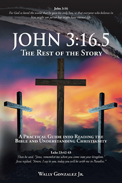
 |
John 3:16.5: The Rest of the Story: A Practical Guide into Reading the Bible and Understanding Christianity
by Wally Gonzalez Jr.
Christian Faith Publishing
At the core of the author’s effort in John 3:16.5 is a determination to make the Bible more comprehensible and relatable to all audiences. What ensues is a work that delves into the well-known stories of scripture minus the intricate complexities and dense language. Though one can make the claim that there is nothing new within this work, it is imperative for readers to understand the unique commentary and angles that add immense insight to monumental biblical events like Jesus Christ’s crucifixion.
Structured with verses followed by insightful commentary from the author, the guide is an ideal blueprint for effectively reaching twenty-first-century readers. In particular, the direct nature of the passages and commentary creates both an educational and enriching experience that can keep all audiences connected, be it in church during mass, in Sunday school with the youth, or in any other setting. Even for seasoned veterans of biblical scripture, the clarity of the verses will be refreshing and a nuanced opportunity to heighten their foundation of the Bible as well as use it in practical application.
One of the prime examples introduced by the author early in this guide is the notion of inclusiveness. On numerous occasions, the idea of mankind being part and parcel of God is presented, sometimes as “We are many parts, yet one body,” and other times as “I am the vine, and you are the branches.” The ripples of Christianity, as the author states, stem from the crucifixion and the subsequent peeling back of the veil to show the Word of God. What is perhaps most ironic is that from an act of such hate toward Jesus is derived the secret to the unifying factor of all life: unconditional love.
From John the Baptist’s mission to a scintillating discussion on the necessity to create imperfect beings who learn to adjust and topics of reconciliation, there are tremendous life lessons hidden in plain sight within these parables and scriptures. After all, the Bible shows Jesus’ own humanity and how he became emblematic of choosing to obey God and resist temptation, paving a path for the rest of humanity to follow. Digging deeper, Gonzalez takes readers through a timeline of 2,000 years and 266 popes, initiated by Christ’s words to St. Peter in Matthew 16:18.
Working his way from the Old Testament (Genesis, Leviticus, Deuteronomy) to the New Testament (John, Luke, Matthew, Mark), the author shows how mass in the churches came to be, marked by Jesus’ resurrection and resurgence. Interestingly, the author’s attempts to integrate relatable metaphors, such as comparing mass to pre-season training camps in sports, are integrated effortlessly and are one of the primary reasons that this compilation of verses is more digestible and has retention capabilities for younger age groups. This unassuming nature of the author is tailor-made to capture the attention of anyone even remotely curious about taking their knowledge of biblical scripture further. Above all else, it is the care and grace with which Gonzalez guides readers through the comprehensive nature of the Bible that makes it not just a meaningful experience but one that is thought-provoking and which will prompt readers to continue their journey as seekers of the truth.
RECOMMENDED by the US Review